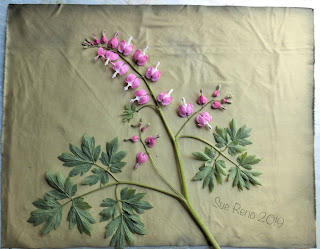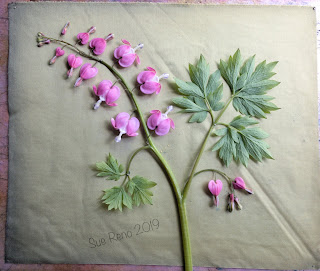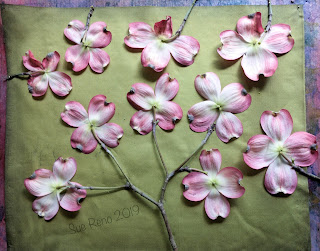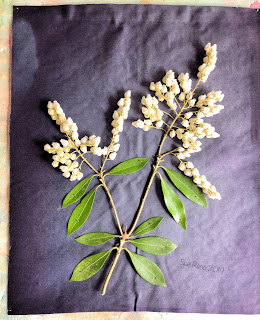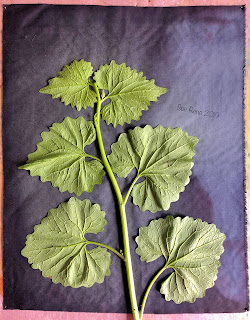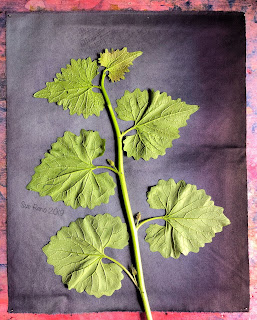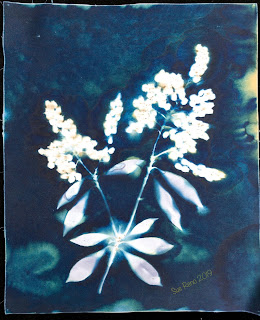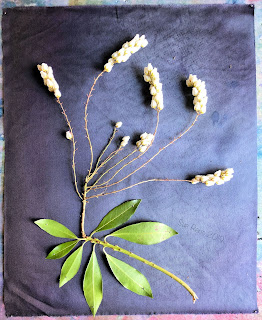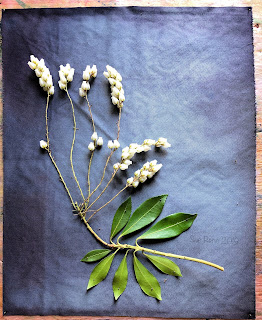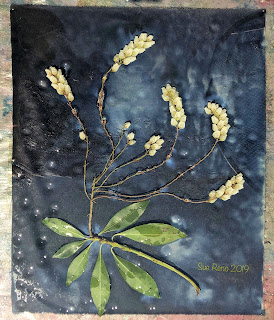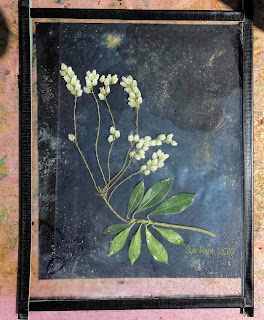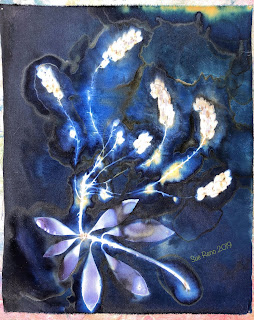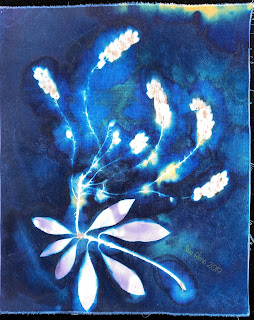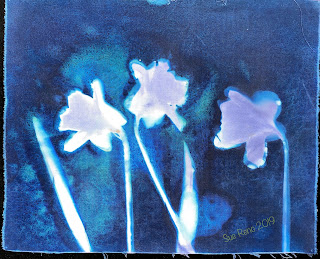I'm a bit short on both time and materials at the moment, but the allure of the bleeding heart in bloom was impossible to resist, so I fit in a few new wet cyanotype prints. The first is 16" x 20", and the second is 10" x 12", both on cotton sateen. These are standard sizes for me, as they match the glass I have on hand, and are a good size for components for my art quilts.
I also did a print of the pink dogwood in bloom, because how could I not?
As I've said before, timing the exposure for delicate flowers is a delicate thing. I want enough sun and heat to work that old wet cyan magic, but no so much that it burns out and overexposes the delicate blossoms.
For these it meant moving them back and forth between sun and shade a few times until I deemend them done. Total exposure was about 3 hours, in 72F weather. These exposed, unrinsed prints are already looking good.
I wasn't as worried about the dogwood exposure, because the sepals (the part we think of as the flowers) is fairly thick and tough. However, that same thickness meant it didn't have consistent contact with the fabric, despite using my heaviest pane of glass. In retrospect, it would have benefited from being pressed briefly before setup.
Here are the finished prints. Both bleeding heart prints turned out just delightful.
There's lots of good detail, with the just the right amount, to my taste, of wet cyan weirdness.
I first I was a bit dismayed by the dogwood, it has elements of the dreaded blobiness because of the imperfect contact. But it's growing on me; with the right amount of stitching to delineate the shapes, and maybe some beadwork for the centers of the sepals, and some pebble stitching on the background, I think it could be lovely. So it's going in the "someday" pile and not the "cutter" pile.
I don't do things by the numbers, generally, but it didn't escape my attention that with this post I've exceeded 600 photos of wet cyan works in progress, spread out over 38 blog posts. If you've got a lot of curiosity and some time on your hands, you can read the whole epic saga, in reverse chronological order, by clicking on the wet cyanotype tab at the top, or going here.
You can also follow along on your social media of choice:
Facebook page:http://www.facebook.com/suerenostudio
Twitter feed: http://twitter.com/suereno
Tumblr: http://suerenostudio.tumblr.com
Instagram: https://www.instagram.com/sue_reno_studio/
April 22, 2019
April 19, 2019
Experiments in wet cyanotype - part 37
Welcome to part 37 of my ongoing experiments with and documentation of the wet cyanotype process. I began this batch, on a gorgeous spring day, with an equally gorgeous and newly emerged flowering sprig of bleeding heart.
I followed that up with an equally beautiful sprig of Japanese andromeda, aka Pieris. This is the third installment I've done this spring, as it has progressed from buds to full bloom.
And then, because nothing else in in leaf yet, I moved on to two panels of garlic mustard. This is an invasive non-native plant, the scourge of my garden and especially of the woodlands, but it does make for some interesting prints. All of these are on cotton sateen that I treated with the cyanotype chemicals. This time around I didn't use any enhancements, just water. The weather was around 70F and partly cloudy, which sometimes works better than full sun for capturing blossoms.
Here are the exposed, unrinsed prints. I could tell right away that the cyanotype gods were on my side/I had done a good job with the exposure timing.
Lots of small brown dots from a bit of eco-printing on these flowers; already beautiful.
And look at the much-disparaged garlic mustard! The leaves shrank as it exposed, leaving a sort of double outline, and there's just a sterling fire-and-lightning effect on the right.
There's good stuff going on here also.
Here are the finished prints. Every so often I think I'm done with this process, I have enough prints already, and then this happens:
I'm so excited by this batch of prints.
The ultimate goal for my cyanotype prints is to include them in a larger work of art. These are going to look so great when I add the stitching.
So fancy and frilly!
If you are a regular reader, thanks for stopping by!
If you are new here, you can follow all 37 parts of my wet cyanotype adventure, with all the tips and tricks and images, by clicking on the Wet Cyan tab in the top header, or by going here.
You can also follow along on your social media of choice:
Facebook page:http://www.facebook.com/suerenostudio
Twitter feed: http://twitter.com/suereno
Tumblr: http://suerenostudio.tumblr.com
Instagram: https://www.instagram.com/sue_reno_studio/
I followed that up with an equally beautiful sprig of Japanese andromeda, aka Pieris. This is the third installment I've done this spring, as it has progressed from buds to full bloom.
And then, because nothing else in in leaf yet, I moved on to two panels of garlic mustard. This is an invasive non-native plant, the scourge of my garden and especially of the woodlands, but it does make for some interesting prints. All of these are on cotton sateen that I treated with the cyanotype chemicals. This time around I didn't use any enhancements, just water. The weather was around 70F and partly cloudy, which sometimes works better than full sun for capturing blossoms.
Here are the exposed, unrinsed prints. I could tell right away that the cyanotype gods were on my side/I had done a good job with the exposure timing.
Lots of small brown dots from a bit of eco-printing on these flowers; already beautiful.
And look at the much-disparaged garlic mustard! The leaves shrank as it exposed, leaving a sort of double outline, and there's just a sterling fire-and-lightning effect on the right.
There's good stuff going on here also.
Here are the finished prints. Every so often I think I'm done with this process, I have enough prints already, and then this happens:
I'm so excited by this batch of prints.
The ultimate goal for my cyanotype prints is to include them in a larger work of art. These are going to look so great when I add the stitching.
So fancy and frilly!
If you are a regular reader, thanks for stopping by!
If you are new here, you can follow all 37 parts of my wet cyanotype adventure, with all the tips and tricks and images, by clicking on the Wet Cyan tab in the top header, or by going here.
You can also follow along on your social media of choice:
Facebook page:http://www.facebook.com/suerenostudio
Twitter feed: http://twitter.com/suereno
Tumblr: http://suerenostudio.tumblr.com
Instagram: https://www.instagram.com/sue_reno_studio/
April 9, 2019
In Dreams I Slept in a Cabin - Acceptance to Art of the State
Update 6/23/19 I am thrilled to announce that In Dreams I Slept in a Cabin was awarded Third Prize, Craft, at the opening of the exhibit.
I am very happy and honored to share that my latest work In Dreams I Slept in a Cabin has been accepted for Art of the State Pennsylvania 2019.
This is a highly competitive exhibit featuring the finest work by Pennsylvania residents in the categories of Painting, Work on Paper, Photography & Digital Arts, Sculpture and Craft.
I am often compelled to make large scale works, like this one at 55" x 94", because I need that scale to tell the story I envision. It can be hard to find exhibit venues for work of this size though, so I am doubly delighted to be included here. The Museum gallery has the space to display work like this with room to breathe, and the lighting and other details are always impeccably handled.
The opening reception is June 23, 1:30 - 5:00, and the exhibit runs until September 8th. If you are in the area I hope you find an opportunity to visit the Museum, it has a lot to offer.
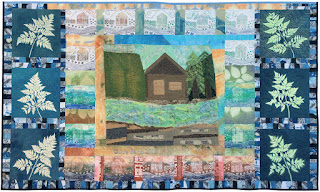 |
| In Dreams I Slept in a Cabin |
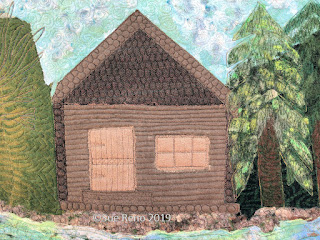 |
| In Dreams I Slept in a Cabin, detail 1 |
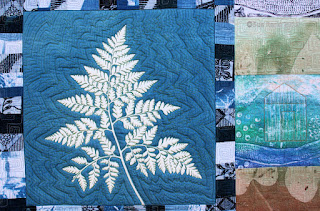 |
| In Dreams I Slept in a Cabin, detail 2 |
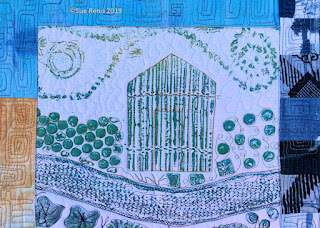 |
| In Dreams I Slept in a Cabin, detail 4 |
April 7, 2019
Experiments in wet cyanotype - part 36
While waiting as patiently as possible for things to leaf out and the wet cyanotype printmaking season to start up on earnest, I made a few quick prints. The Pieris andromeda prints with buds turned out nicely a few weeks ago, so I repeated the experiment with them in bloom.
The first one I did straight, with just water, and on the second one I added some soda ash around the edges. These are all on cotton sateen I treated with the cyanotype chemicals. Here they are under glass and starting to process.
I kept the exposure time relatively short, about 90 minutes, because that's all the longer the fragile flowers lasted.
Dimensional flowers, like daffodils or irises, are not good candidates for this technique. They get smushed under the glass and a lot of detail gets lost. I did some daffodil prints last spring and they ended up basically as blobs (which I then cut up and used in patchwork). I knew this, and yet here I was, with a sunny day and a yard full or daffodils and the hope that springs eternal in the heart of an experimentalist, so I gave it another go.
Here are the exposed, unrinsed prints. I'm very happy with this one:
And also with this one--a very dramatic example of the difference the soda ash can make.
And I felt cautiously optimistic about this one. Again, I tried to hit the sweet spot for exposure length.
Here are the finished, rinsed and ironed prints. I love the delicacy of this one:
And I also love the energy here:
The daffodil print is my best to date, but still not up to my standards. But that's ok! The whole point here is to experiment, hone my skills, and learn from each session, so it still counts as a success.
If you are a regular reader, thanks for stopping by!
If you are new here, you can follow all 36 parts of my wet cyanotype adventure, with all the tips and tricks and images, by clicking on the Wet Cyan tab in the top header, or by going here.
You can also follow along on your social media of choice:
Facebook page:http://www.facebook.com/suerenostudio
Twitter feed: http://twitter.com/suereno
Tumblr: http://suerenostudio.tumblr.com
Instagram: https://www.instagram.com/sue_reno_studio/
The first one I did straight, with just water, and on the second one I added some soda ash around the edges. These are all on cotton sateen I treated with the cyanotype chemicals. Here they are under glass and starting to process.
I kept the exposure time relatively short, about 90 minutes, because that's all the longer the fragile flowers lasted.
Dimensional flowers, like daffodils or irises, are not good candidates for this technique. They get smushed under the glass and a lot of detail gets lost. I did some daffodil prints last spring and they ended up basically as blobs (which I then cut up and used in patchwork). I knew this, and yet here I was, with a sunny day and a yard full or daffodils and the hope that springs eternal in the heart of an experimentalist, so I gave it another go.
Here are the exposed, unrinsed prints. I'm very happy with this one:
And also with this one--a very dramatic example of the difference the soda ash can make.
And I felt cautiously optimistic about this one. Again, I tried to hit the sweet spot for exposure length.
Here are the finished, rinsed and ironed prints. I love the delicacy of this one:
And I also love the energy here:
The daffodil print is my best to date, but still not up to my standards. But that's ok! The whole point here is to experiment, hone my skills, and learn from each session, so it still counts as a success.
If you are a regular reader, thanks for stopping by!
If you are new here, you can follow all 36 parts of my wet cyanotype adventure, with all the tips and tricks and images, by clicking on the Wet Cyan tab in the top header, or by going here.
You can also follow along on your social media of choice:
Facebook page:http://www.facebook.com/suerenostudio
Twitter feed: http://twitter.com/suereno
Tumblr: http://suerenostudio.tumblr.com
Instagram: https://www.instagram.com/sue_reno_studio/
July 2022 Update: This post has been doing some numbers, so I wanted to say hello, and thank you, to everyone stopping by. I also wanted to let you know that this exploration turned into a series of 78 posts, and counting! You can easily access them, in reverse chronological order, by clicking on the Wet Cyanotype tab in the top header. I share a lot of details about what I've tried, and am always honest about the results in each post. Mixed in is the occasional post showing artquits I've made with my prints. I hope you enjoy reading my blog, learn a thing or two, and try your own hand at this very enjoyable process.
Subscribe to:
Posts (Atom)
